The Enola Gay, a Boeing B-29 Superfortress bomber, is a significant part of history. It was named after the mother of its pilot, Colonel Paul Tibbets, and it symbolizes the end of World War II.

On August 6, 1945, the Enola Gay carried out the first-ever combat mission with an atomic bomb, targeting Hiroshima in Japan. This action sped up the end of the war and marked the start of the nuclear age.
In this article, we’ll look at the Enola Gay’s history, its development, the people who flew it, the missions it carried out, and where it is now.
Let’s get started!
Construction and Design of the Enola Gay
The Enola Gay, a “Silverplate” Boeing B-29 Superfortress (B-29-45-MO, serial number 44-86292), was assembled at the Glenn L. Martin Aircraft Plant in Omaha, Nebraska, and manufactured by the Boeing Aircraft Company.
Colonel Paul W. Tibbets, the Commanding Officer of the 509th Composite Group, personally selected the aircraft on May 9, 1945, during a visit to the bomber plant. He meticulously chose the best B-29 from the production line, ensuring it was the ideal specimen he would use when he flew missions and especially for the first atomic bombing mission.
The Boeing B-29 Superfortress
And for this special mission, the best bomber in the U.S. Arsenal was chosen. Indeed, the B-29 was a groundbreaking bomber during World War II, known for its size and technological advancements.
With a wingspan of 141 feet and a 99-foot-long fuselage, it could carry up to 22,000 pounds of bombs and had an effective combat range of 3,200 miles. It was the first fully pressurized combat aircraft, significantly reducing crew fatigue.
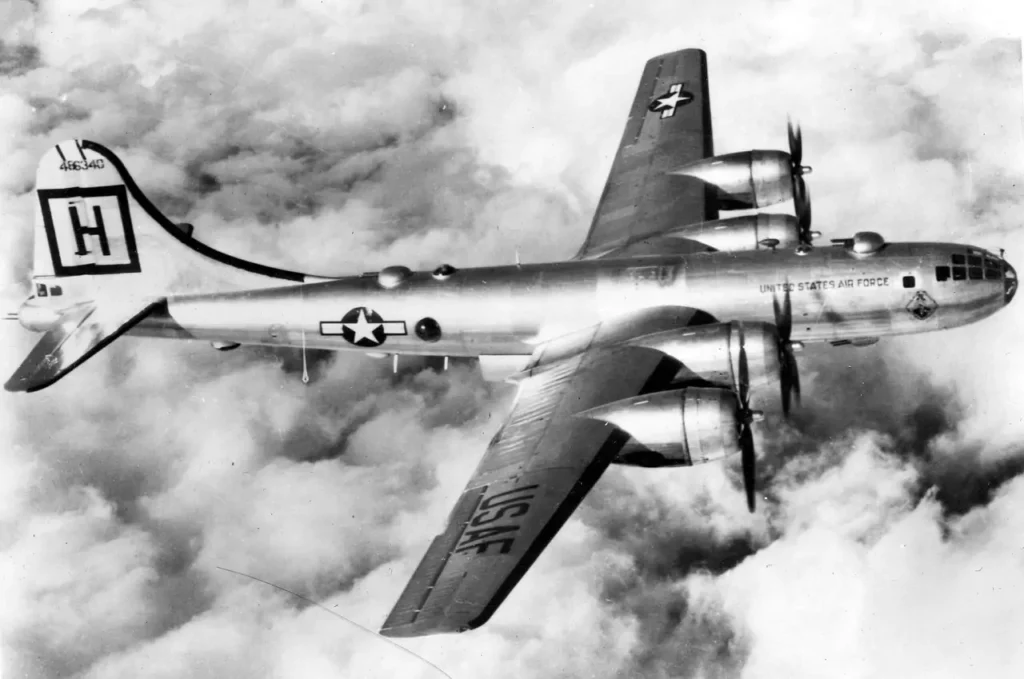
The B-29 also pioneered the use of ground-mapping radar in combat aircraft and featured innovative interception and communication technologies. Its remote-controlled turrets with early computer systems for targeting increased accuracy, making it a formidable weapon of war and a key player in the campaign against Japan.
“Silverplate” bombers
In addition, the Enola Gay was not a simple B-29 but one of fifteen special B-29s called “Silverplate” used by the 509th Composite Group on Tinian during World War II. The Enola Gay, along with 19 other B-29s, was delivered in the first half of 1945 as part of the second phase of Silverplate modifications.
These “Silverplate” bombers were a special version of the Boeing B-29 Superfortress, designed specifically to carry atomic bombs.
In short, the B-29 bomber was a technical marvel, but dropping an atomic bomb weighing about 10,000 pounds at 30,000 feet forced a “normal” B-29 to operate beyond its design specifications.
As a result, changes made to these “Silverplate” B-29s included an improved engine, better-braking propellers, weight reduction by removing weapons and armor, fast-opening bomb bay doors, better bomb support systems, and an added role of an electronics test officer to keep track of the atomic bomb during flight.
The 509th Composite Group
The 509th Composite Group was activated at Wendover Field, Utah, on December 17, 1944, and stationed in Roswell, New Mexico. Under the command of Colonel Tibbets, their job was to deliver atomic bombs to Japan by air.
This group had to overcome significant challenges related to aviation technology to safely and accurately deliver nuclear weapons. Each plane had to drop a single five-ton bomb, then quickly turn and ascend to reduce the risk of the explosion blast and flash when the bomb went off.
To solve these issues, the U.S. Army Air Force chose the 509th Composite Group to create and practice the necessary strategies for these tasks. Their hard work led to the successful drop of the atomic bomb known as “Little Boy” on Hiroshima on August 6, 1945.
Paul Tibbets
A full story of the Enola Gay must include Paul W. Tibbets Jr. He was a top U.S. bomber pilot during World War II and the leader of the 509th Composite Group. Tibbets’ expertise led to him piloting the Enola Gay on its historic Hiroshima mission.
Native of Quincy, Illinois, Paul W. Tibbets began his military career with the Army’s air cadet program in 1937. As a bomber pilot at the outset of World War II, he initially flew anti-submarine patrols on the U.S. east coast before joining the Eighth Air Force in England, where he piloted B-17 Flying Fortress bombers.
Tibbets was part of the first U.S. air strike on German-occupied Europe and later transported Lieutenant General Dwight D. Eisenhower to Gibraltar in preparation for the British-American invasion of North Africa.
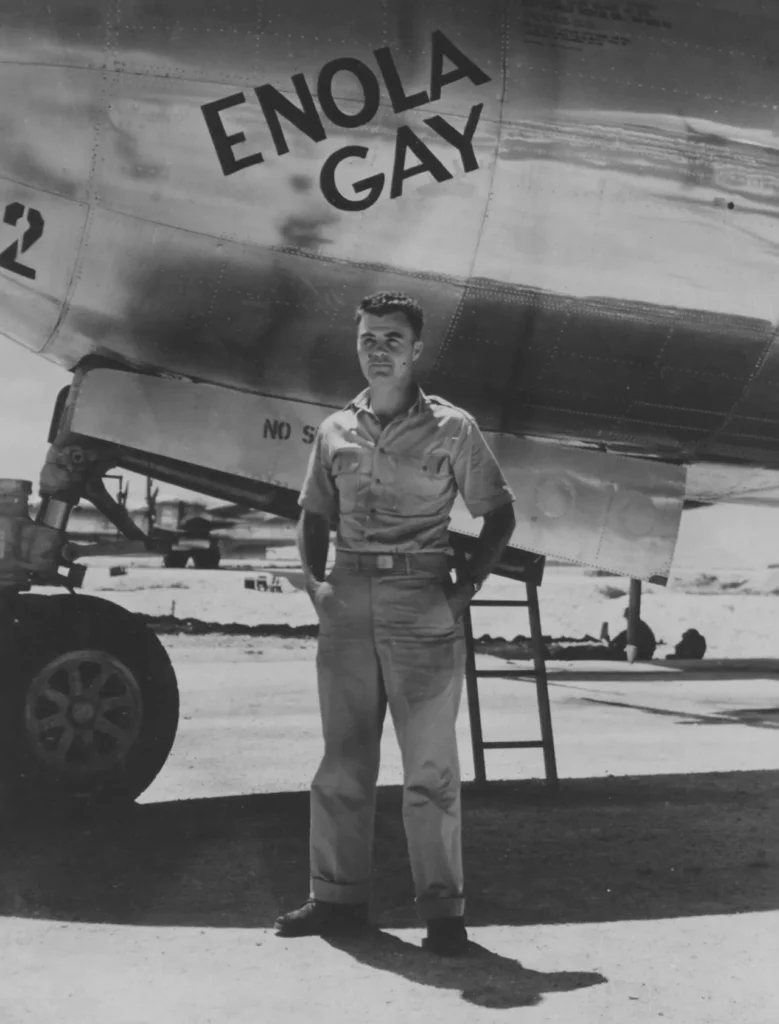
After serving in North Africa, Tibbets returned to the U.S. in 1943 to transition to the B-29 Superfortress bomber. He functioned as a military test pilot, helped train the first combat crews, and established a school for B-29 flight instructors.
Finally, in December 1944, Tibbets was selected to command the 509th Composite Group.
If you are interested to know more about Tibbets’s life, read our biography about Paul W. Tibbets Jr.
Wendover Army Air Field
The B-29 Enola Gay, commanded by Robert A. Lewis and crew B-9, flew from Omaha to Wendover Army Air Field in Utah on June 14, 1945.
Wendover, 110 miles west of Salt Lake City near Nevada, was chosen by Colonel Paul Tibbets because it was remote, providing good security for the top-secret 509th Composite Group. This special group included an aerial squadron with fifteen B-29s, a transport squadron, and an ordnance squadron that assembled a very powerful weapon. It had its own engineering, maintenance, and military police units.
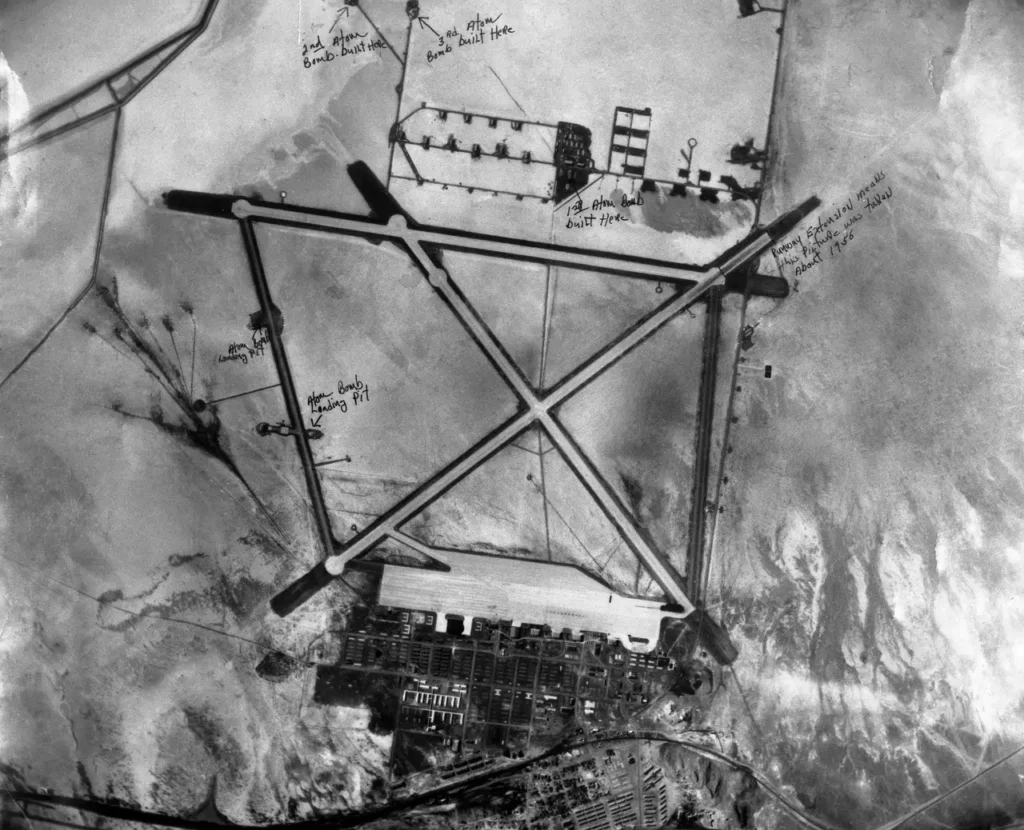
While at Wendover, the Enola Gay was used for training and practice bombing missions. The 509th Composite Group spent months dropping 10,000-pound concrete bombs, or “pumpkins,” to get ready for the actual mission. Wendover Army Air Field, sometimes called Kingman or W-47, was the training and test center for the new Atomic Bomb Group.
In total, 46 Silverplate B-29s were based at Wendover at different times, with 35 of them assigned to the 509th over an 11-month period from October 1944 to August 1945.
Enola Gay’s Crew
Enola Gay was generally assigned to Crew B-9, with Robert A. Lewis as the Airplane Commander for all combat missions.
However, Paul W. Tibbets typically chose the Enola Gay and members of crew B-9 when he flew missions. When this happened, the usual Airplane Commander, Robert A. Lewis, took on the role of the pilot, and other crew members were swapped out based on the specific requirements of the mission.
For the historic Hiroshima mission, the crew included Thomas W. Ferebee as the bombardier and Theodore J. Van Kirk as the navigator. The rest of the crew positions were occupied by members of crew B-9.
The personnel of Crew B-9 was:
| Position | Name |
|---|---|
| Airplane Commander | Robert A. Lewis |
| Pilot | Richard McNamara |
| Navigator | Harold J. Rider |
| Bombardier | Stewart W. Williams |
| Flight Engineer | Wyatt E. Duzenbury |
| Radio Operator | Richard H. Nelson |
| Radar Operator | Joseph S. Stiborik |
| Tail Gunner | George R. Caron |
| Assistant flight engineer/Scanner | Robert H. Shumard |
| Ground Crew | Steve C. Lizak |
| Ground Crew | Leonard W. Markley |
| Ground Crew | Jean S. Cooper |
| Ground Crew | Winfield C. Kinkade |
| Ground Crew | John E. Jackson |
| Ground Crew | John J. Lesniewski |
| Ground Crew | Harold R. Olson |
Source: The Silverplate Bombers: A History and Registry of the Enola Gay and Other B-29s Configured to Carry Atomic Bombs by Richard H. Campbell
Tinian North Field
After finishing their training in Wendover, Utah, the 509th Composite Group moved to Tinian, in the Mariana Islands, in late May 1945. This small island, about 38 square miles and shaped like Manhattan, became the group’s base for operations from June to November 1945.
Tinian was a busy place with over 40,000 people and hundreds of aircraft. Colonel Paul W. Tibbets was assigned the North Field of Tinian, which had four large runways, each 8,500 feet long. This area housed 269 B-29 bombers.
This island was important during World War II because it was close to Tokyo, only 1,500 miles away. This was close enough for the many B-29 bombers at five bases across Tinian, Saipan, and Guam in the Marianas to reach.
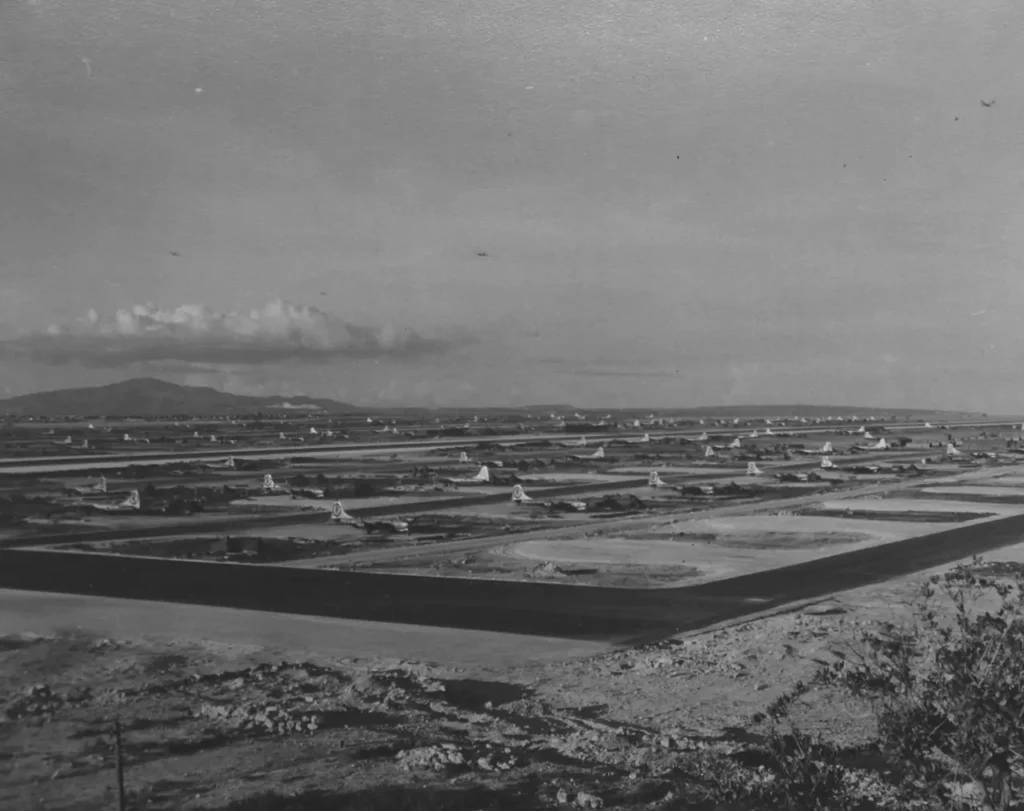
The Enola Gay, flown by Lewis and crew B-9, traveled from Wendover to Tinian North Field on June 27, 1945. There, she got the call sign Victor 12, but this was later changed to Victor 82.

The B-29s used in the Pacific during World War II, including the Enola Gay and the other Silverplate B-29s of the 509th Composite Group, had a unit marker on the vertical stabilizer/rudder surface. The 509th marker was a forward-facing arrow in a circle, used until the atomic bombing missions.
Training and practice
As soon as the 393rd crews arrived at Tinian, they went through a training program. This helped them learn about 20th Air Force procedures and how air operations worked at Tinian. After the ground training, they took part in seven training and practice flights. In total, they flew 27 times.

Also, they did 15 practice bombing missions on nearby islands still controlled by Japan between July 1 and August 2, 1945. During these missions, the 393rd’s Silverplate B-29s flew 89 times. They dropped a mix of 500- and 1,000-pound bombs on the islands of Rota, Truk, Guguan, and Marcus. But, these practice bombings didn’t count towards their combat mission credit.
The Enola Gay was used for eight training and practice bombing missions.
Pumpkins bombs
Starting July 20, 1945, the 509th began a set of missions where they dropped 10,000-pound bombs called “pumpkins” on targets in Japan. These pumpkins were basically Fat Man bomb shells filled with a heavy explosive called Composition B. They were set to explode on impact and didn’t have radar-operated airburst capabilities.
In the 16 missions, the 393rd’s Silverplate B-29s flew 51 times. However, only 49 pumpkin bombs were dropped because of two aborted missions. In one, the pumpkin bomb was dropped near Iwo Jima. On the other, the bomb was brought back to Tinian safely.
Enola Gay Pumpkins missions:
- On July 24, 1945, according to Operations Order 24, the Enola Gay dropped a pumpkin bomb on the main target – a steelworks in the Kobe area. They used visual bombing, but the effects weren’t recorded.
- Then, on July 26, 1945, under Operations Order 27, the Enola Gay dropped another pumpkin bomb. This time it was on a secondary target, the urban area of Nagoya. They used radar bombing, but again, the results were not recorded.
Little Boy tests
Before the Hiroshima and Nagasaki missions, five different aircraft from the 393rd ran tests near Tinian. These tests took place in late July and early August 1945, and involved dropping both Little Boy and Fat Man models. These tests were for the Los Alamos team at Tinian who were supporting the atomic bomb missions.
Four of these tests involved dropping Little Boy units, while one tested how well a Little Boy model could be loaded and unloaded at Iwo Jima. There were also three Fat Man units dropped before the Nagasaki mission. These tests helped the crews prepare for the Hiroshima and Nagasaki missions.
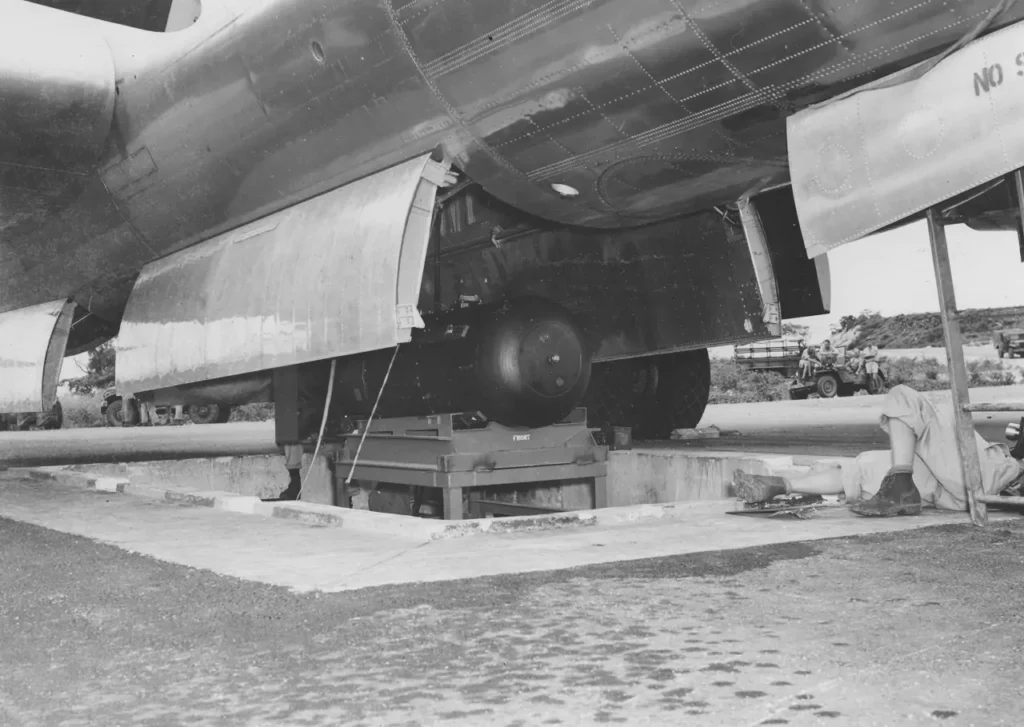
The last Little Boy test before the Hiroshima mission happened on July 31. They loaded test unit L6 into Enola Gay, with Tibbets as the commander. In this final practice run, the bomb-carrying plane and two other Silverplate B-29s from the 509th flew to Iwo Jima, where they met up. They then went back near Tinian, dropped the test unit, and saw that it worked properly.
Naming the Enola Gay
On August 5, 1945, the day before the Hiroshima mission, Paul Tibbets decided to name the aircraft “Enola Gay”. This was the only plane in the 509th that got a name and nose art before August 9, 1945.
Allan L. Karl, who was part of the 509th operations, was told to paint the name on the left side of the plane’s nose, under the cockpit.

In a letter from May 16, 1978, Tibbets explained to author Samuel S. Kloda that the pilots and crews often named their planes. They could be inspired by people, cities, or unique names.
Tibbets knew that his plane would be remembered, so he picked “Enola Gay”, a name that was unique and not offensive. He named the plane after his mother, who had always supported his love for flying and was the only one in his family who didn’t try to stop him from having a career in it.
Hiroshima Mission
On August 6, 1945, the Enola Gay, piloted by Paul Tibbets and his crew, made history by dropping the Little Boy atomic bomb on Hiroshima. To hide who they were, the crew changed their call sign from Victor to Dimples and used a circle with an R inside it on the tail of the plane.
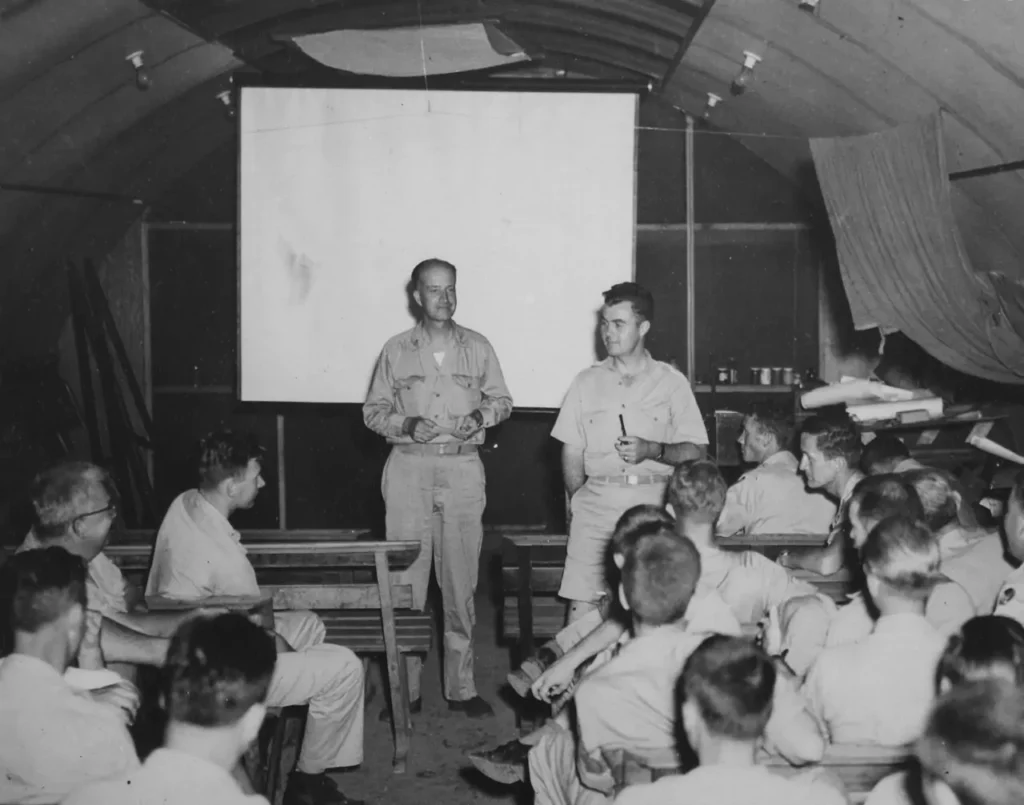
The mission involved seven Silverplates B-29 planes. Three were used for checking the weather, one for measuring the blast, one for taking pictures of the explosion, and one was kept ready at Iwo Jima as a backup. The Enola Gay was the one that carried the bomb.
For the Hiroshima atomic bombing mission, the aircraft, crews, and functions were:
| Aircraft | Name | Crew | Airplane Commander | Function |
|---|---|---|---|---|
| 44-86292 | Enola Gay | B-9 | Tibbets | Carried Little Boy atomic bomb |
| 44-27353 | The Great Artiste | C-15 | Sweeney | Blast measurement instrumentation |
| 44-86291 | No. 91 / Necessary Evil | B-10 | Marquardt | Photographic equipment |
| 44-27301 | Straight Flush | C-11 | Eatherly | Advanced weather at Hiroshima |
| 44-27303 | Jabit III | B-6 | Wilson | Advanced weather at Kokura |
| 44-27298 | Full House | A-1 | Taylor | Advanced weather at Nagasaki |
| 44-27354 | Big Stink | B-8 | McKnight | Backup at Iwo Jima |
Source: The Silverplate Bombers: A History and Registry of the Enola Gay and Other B-29s Configured to Carry Atomic Bombs by Richard H. Campbell
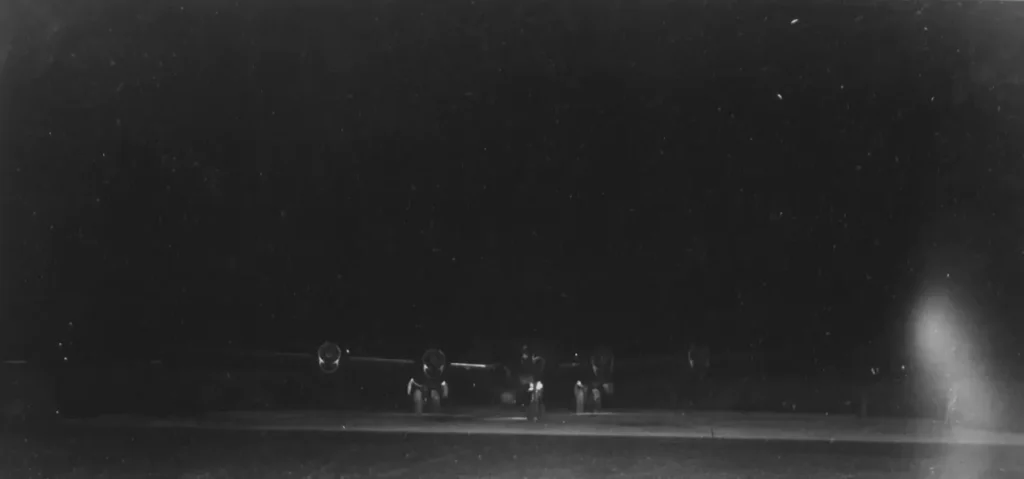
This mission, known as the 20th Air Force Special Bombing Mission Number 13, was explained in the 509th Operations Order Number 35. The Enola Gay left at 2:45 in the morning, Tinian time. It dropped the bomb over Hiroshima at 9:15 in the morning and got back to Tinian at 2:58 in the afternoon. The whole mission took 12 hours and 13 minutes.
| Rank | Name | Position |
|---|---|---|
| Colonel | Paul W. Tibbets | Pilot and aircraft commander |
| Captain | Robert Lewis | Co-pilot and aircraft commander |
| Captain | Dutch Van Kirk | Navigator |
| Major | Tom Ferebee | Bombardier |
| Navy Captain | William "Deak" Parsons | Weaponeer and mission commander |
| First Lieutenant | Jacob Beser | Radio countermeasures (only person to fly on the strike plane on both atomic bombing missions) |
| Second Lieutenant | Morris Jeppson | Assistant weaponeer |
| Sergeant | Robert Shumard | Assistant flight engineer |
| Private First Class | Richard Nelson | VHF radio operator |
| Sergeant | Joseph Stiborik | Radio operator |
| Staff Sergeant | Wyatt Duzenbury | Flight engineer |
| Technical Sergeant | George Caron | Tail gunner |
Source: The Silverplate Bombers: A History and Registry of the Enola Gay and Other B-29s Configured to Carry Atomic Bombs by Richard H. Campbell

After Hiroshima
While many people think the Enola Gay didn’t take part in any more combat missions after Hiroshima, records show it was actually used in the Nagasaki atomic bombing mission on August 9, 1945.
Under the command of George W. Marquardt and crew B-10, the Enola Gay was used to check the weather over Kokura, the mission’s main target.
After the war ended in August 1945, Robert A. Lewis and crew B-9 used the aircraft for two more training exercises.
Then, on November 6, 1945, Lewis and his crew flew the Enola Gay from Tinian back to the United States. They landed at Roswell Army Air Field in New Mexico on November 8, where they joined the rest of the 509th’s B-29s and crews.
Enola Gay mission list during her time in Tinian:
| Opns Order | Combat Msn | Date (1945) | Purpose of Mission | Aircraft Comamnder | Crew |
|---|---|---|---|---|---|
| 9 | - | 7 July | Bomb Marcus | Devore | A-3 |
| 14 | - | 12 July | Bomb Rota | Price | B-7 |
| 16 | - | 17 July | Training | Lewis | B-9 |
| 17 | - | 18 July | Training | Lewis | B-9 |
| 18 | - | 18 July | Bomb Guguan | Lewis | B-9 |
| 19 | - | 19 July | Bomb Guguan | Wilson | B-6 |
| 21 | - | 21 July | Bomb Marcus | Lewis | B-9 |
| 22 | - | 22 July | Practice bombing | McKnight | B-8 |
| 24 | 6 | 24 July | Pumpkin bomb | Lewis | B-8 |
| 27 | 9 | 26 July | Pumpkin bomb | Lewis | B-8 |
| 31 | - | 31 July | Little Boy L6 test | Tibbets | B-9 |
| 35 | 13 | 6 August | Hiroshima/Little Boy L11 | Tibbets | B-9 |
| 39 | 16 | 9 August | Weather/Kokura | Marquardt | B-10 |
Source: The Silverplate Bombers: A History and Registry of the Enola Gay and Other B-29s Configured to Carry Atomic Bombs by Richard H. Campbell
Operation Crossroads
In March 1946, the Enola Gay joined Task Force 1.5 for a series of Nuclear Tests called Operation Crossroads. The plane flew from Roswell on April 29, 1946, and arrived at Kwajalein Island by May 1. Paul Tibbets and his team were not picked to drop the Fat Man bomb during Test Able, which was part of this mission.
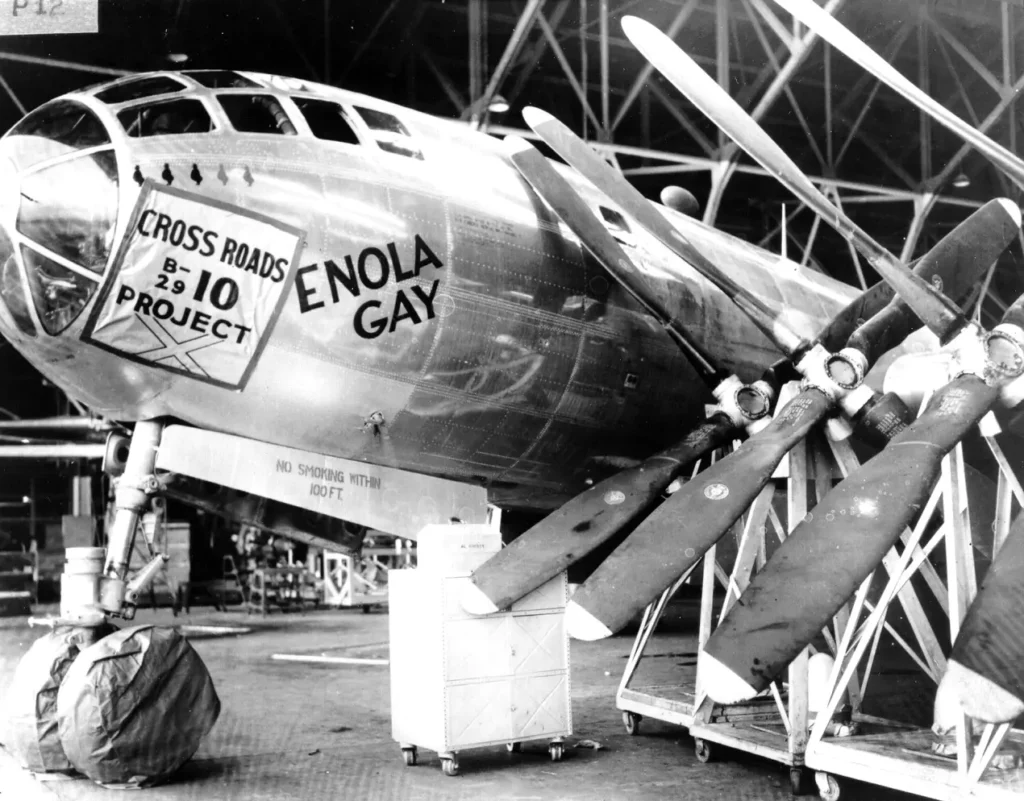
Right after the test on July 1, 1946, Tibbets and his team flew the Enola Gay back to the U.S. from Kwajalein. They reached Fairfield-Suisun Army Air Field in California on July 2, 1946.
Transfer to the Smithsonian
After being used in Operation Crossroads, the Enola Gay was stored at Davis-Monthan Army Air Field in Arizona from July 24, 1946. The Smithsonian Institution then became the owner, and it was no longer part of the U.S. Army Air Forces inventory from August 30, 1946.
On July 3, 1949, three years later, the plane was taken out of storage and flown to Orchard Place Air Field in Park Ridge, Illinois. The flight was led by Paul Tibbets. After it landed, it was given to the Smithsonian.
They planned to fix it up and store it at Park Ridge, which would later be where O’Hare International Airport is. But, when the city of Chicago decided to build the airport there, the Smithsonian moved the Enola Gay to Pyote Air Force Base in Texas on January 12, 1952, to be stored for a short time.
In Storage for 23 years
The Enola Gay was moved to Andrews Air Force Base near Washington, DC, on December 2, 1953. It was left outside and not looked after for over six years in a remote part of the base. On August 10, 1960, staff from the Smithsonian started to take the plane apart to move it to a facility in Suitland, Maryland, where it could be stored and fixed up. The parts arrived there on July 21, 1961, and stayed there for the next 23 years.
At the same time, the B-29 plane Bockscar, which was used for the Nagasaki mission, was put on display at the U.S. Air Force Museum in Dayton, Ohio, in 1961. But the Enola Gay was not shown to the public, even after the National Air and Space Museum in Washington was opened in 1976.
The Smithsonian didn’t display the Enola Gay for a couple of reasons. One was that the plane was part of a controversial topic. Another reason was that the plane was too big to show in the museum. The plane was 99 feet long and had a wingspan of 141 feet. After the museum opened on July 4, 1976, it quickly became very popular, and there was no space for such a big plane.
Restoration
On December 5, 1984, work started to restore the Enola Gay at the Paul E. Garber Facility in Suitland. The famous bomber, which had been taken apart into 52 pieces and stored, was in poor shape by this time.
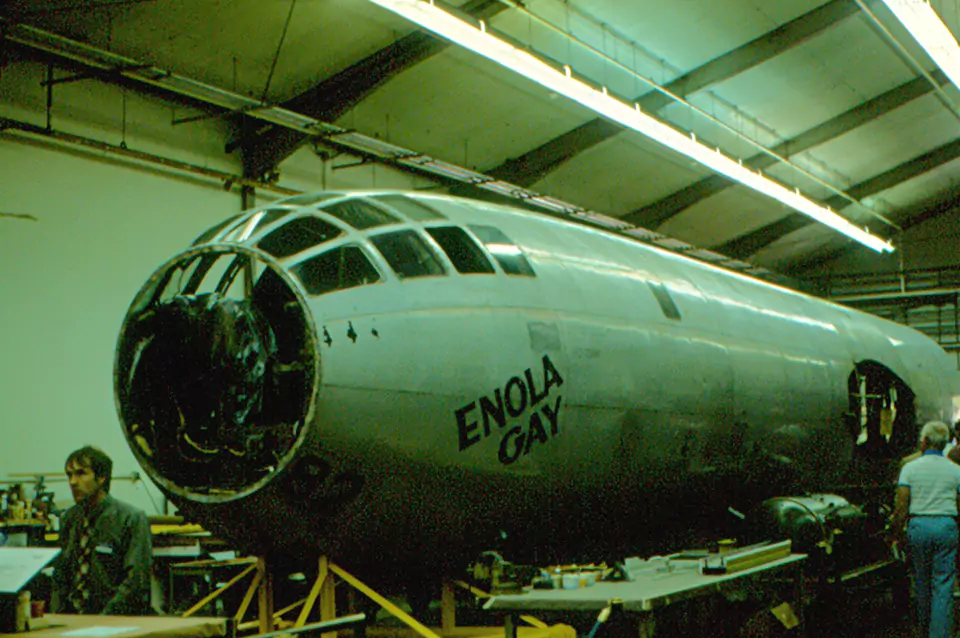
Putting the plane back together was a huge job. The museum staff worked for a total of 300,000 hours on this project, making it the biggest task of this kind that the museum had ever done
The 1995-1998 exhibit
In June 1995, the National Air and Space Museum inaugurated a comprehensive exhibition dedicated to the Enola Gay aircraft and its historic mission. The centerpiece of the exhibit was the forward fuselage of the plane, mounted on the nose wheel, representing over half of the aircraft’s total length. Additional displays included a propeller, the aircraft’s tail, and two engines.
The plane’s tail, restored to its original sheen, was a standout feature of the exhibit. Despite spatial constraints that precluded the full display of the entire 99-foot-long, 141-foot-wide aircraft, the museum managed to exhibit other significant components of the Enola Gay.
The exhibit refrained from any political discourse, a decision that resonated positively with the public. By its conclusion in May 1998, after a three-year run, the exhibit had attracted almost four million visitors, making it the most frequented special exhibition in the museum’s history.
After its successful run, the components of the Enola Gay were returned for additional restoration work.
Full restoration and 2003 exhibit
Following an extensive restoration process involving more than 44,000 hours of meticulous labor, the Enola Gay was finally brought back to its full glory. The renowned aircraft was reassembled and prepared for public viewing, marking the first time it was presented in one piece since 1960.
In December 2003, the Steven F. Udvar-Hazy Center, a significant extension of the National Air and Space Museum, opened in close proximity to Dulles Airport. This expansive new facility provided the ideal setting for the exhibition of the fully restored Enola Gay.
Where to see it?
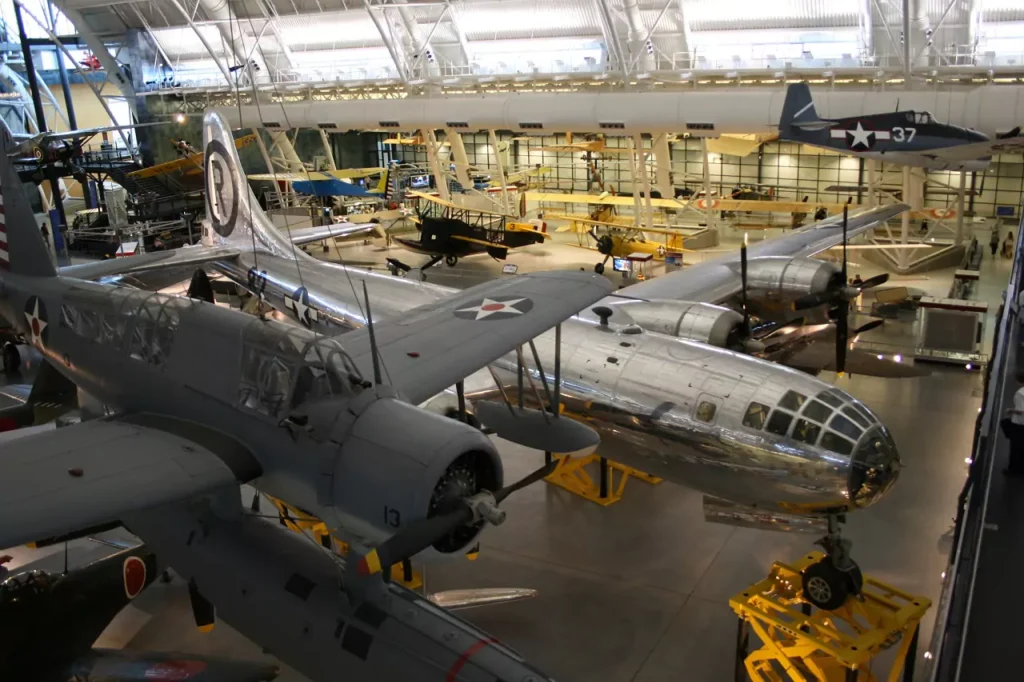
The Enola Gay is the centerpiece of the World War II Aviation Exhibition of the National Air and Space Museum (NASM) in its Steven F. Udvar-Hazy Center in Chantilly, Virginia. You can get more information on the NASM website about the exhibition.
About the Steven F. Udvar-Hazy Center
Google Maps
Address: 14390 Air and Space Museum Parkway Chantilly, VA 20151
Front desk: (703) 572-4118
Operating Hours:
10 am–5:30 pm daily
Website: https://airandspace.si.edu/
The National Air and Space Museum features two distinct locations: one in Washington, DC, and the Steven F. Udvar-Hazy Center in Chantilly, Virginia. The Udvar-Hazy Center, situated near Washington Dulles International Airport, is three times larger than its DC counterpart and houses thousands of aviation and space artifacts in two enormous hangars.
Some of the center’s most notable exhibits include the Space Shuttle Discovery, the SR-71 Blackbird (the world’s fastest jet), a Concorde, and the Enola Gay (the B-29 that dropped the atomic bomb on Hiroshima). Visitors can enjoy a range of experiences, such as observing planes taking off and landing at Dulles from the observation tower, piloting a jet or taking a spacewalk in a simulator, or watching shows at the on-site Airbus IMAX Theater.
Further reading
- Boeing B-29 Superfortress Facts: 11 things to know
- The Enola Gay Chronology
- Surviving B-29 Superfortresses: A Visitor’s Guide
Bibliography
- The Atomic Bomb in Images and Documents – The Manhattan Project and the Bombing of Hiroshima and Nagasaki By Samuel S. Kloda
- The Enola Gay: The B-29 That Dropped the Atomic Bomb on Hiroshima by Norman Polmar
- The Silverplate Bombers: A History and Registry of the Enola Gay and Other B-29s Configured to Carry Atomic Bombs by Richard H. Campbell
- The Smithsonian and the Enola Gay, An Air Force Association Special Report by The Air Force Association